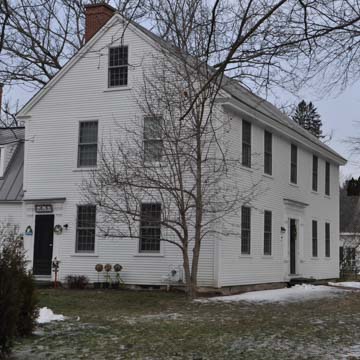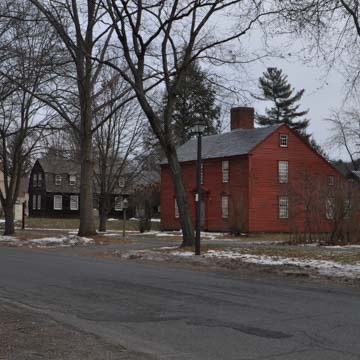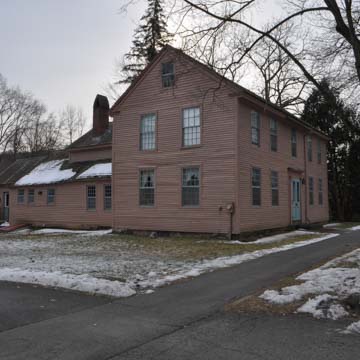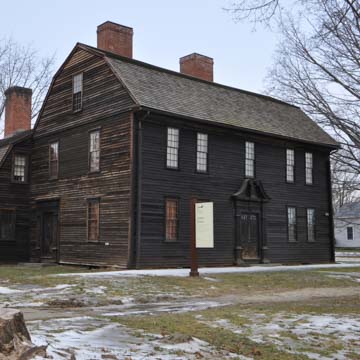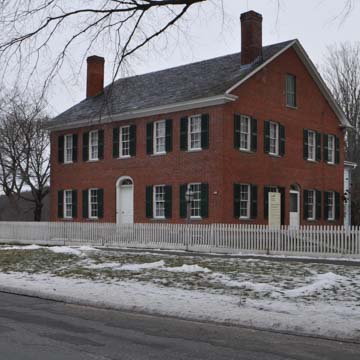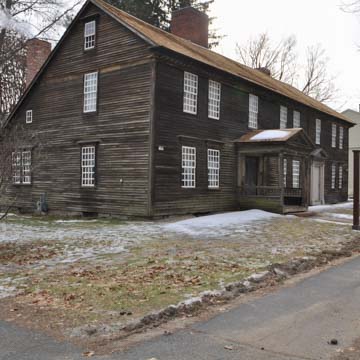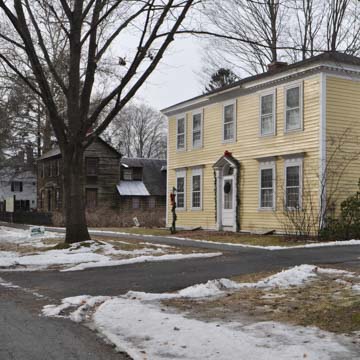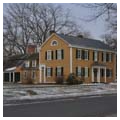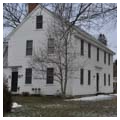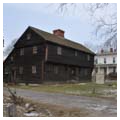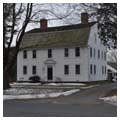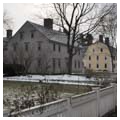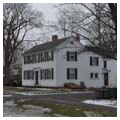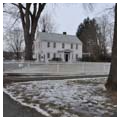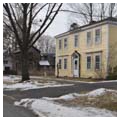Old Deerfield, a National Historic Landmark District, powerfully encapsulates twentieth-century ideals of the Colonial Revival movement through its preservation of eighteenth-century buildings and landscapes. The District contains an assemblage of fifty-three buildings built between 1717 and 1846 reflecting both the exceptional and the mundane in the development of colonial New England’s built environment. Located far inland in the Connecticut River Valley and settled by Europeans remarkably early, Deerfield’s location owed its initial success to natural intervales—meadowlands that facilitated livestock grazing. As a settlement bypassed by later commercial activity, principally railroads, its preservation owes as much to economic decay as to later initiatives to represent a “typical” colonial settlement. Yet today it embodies a striking synthesis of historic buildings and preservationist ideology.
The area now known as Deerfield had been settled by the Pocumtuck tribe before English colonists arrived and purchased the land in 1667. Four years later, civic leaders apportioned forty-three irregular lots and formally laid out the village along a mile-long longitudinal axis today known as “The Street” (Main Street), which forms the basis of the Old Deerfield Historic District. The Street sits on a natural plateau above low-lying, nutrient-rich intervales created by the Deerfield River to its immediate west. The village plateau also lies between low hills west of the Deerfield River and the southern reaches of the wooded Pocumtuck Range, which separates the valley from the larger Connecticut River into which the Deerfield River drains just northeast of the village. Each town lot came with tracts for farming and grazing outside the village on the meadows north or south of the village along the Deerfield River. Other central elements of the town plan included the common and the location of the meetinghouse. However, many of these town lots sat vacant in the seventeenth and early eighteenth centuries, as was typical of New England villages.
Because of its location on the frontier of English settlement, Deerfield endured a substantial amount of conflict. Just four years after initial settlement, Native Americans attacked the village as part of King Philip’s War in 1675, although the town was resettled by 1682. Deerfield was later subjected to more raids, coordinated between the French and Native American allies, during King William’s War in the 1690s. Residents subsequently erected a square log stockade, which enclosed the common, meetinghouse, and fifteen houses, for protection against future attacks. However, another raid was carried out by a diverse group of Native Americans under the guidance of the French as part of Queen Anne’s War in 1704. Subsequently dubbed the “Deerfield Massacre,” residents were able to muster little resistance and forty percent of the population was taken prisoner, while almost the entire village was destroyed. Some buildings did survive the raid, though the last definitively known structure to persist intact was demolished in 1848 despite local preservation efforts.
By the 1750s, Deerfield, no longer on the frontier, had become prosperous through the wheat, tobacco, and cattle industries, utilizing its proximity to the Connecticut River to ship its exports. In 1797, the Massachusetts legislature established a coeducational boarding school, Deerfield Academy, which commissioned Asher Benjamin to design its main building (now Memorial Hall, the museum of the Pocumtuck Valley Memorial Association). The Academy operated with varying amounts of success during the nineteenth century and moved in 1878 to its present campus facing the village common, further stabilizing the town center. Ultimately, Deerfield village lost its competitive edge when the railroad bypassed it for a more convenient junction to the north, forcing the town into a slow economic decline because of restricted access to markets. As a result, Deerfield’s centuries-long period of growth came to a halt. The buildings that constitute the core of Old Deerfield along “The Street,” then, date to the mid-eighteenth through the mid-nineteenth centuries and remained remarkably well preserved precisely because of the economic decline of the area.
Aware of the village’s uniquely conserved state, local groups began to undertake preservation efforts, including the founding of the Pocumtuck Valley Memorial Association in 1870. Some successful preservation efforts, such as one in 1877, stemmed from the perceived, if somewhat dubious, association of extant buildings with the colonial-era raids. After 1902, Deerfield Academy’s headmaster Frank Boyden began purchasing historic properties piecemeal for use by the school’s faculty. However, it was not until 1936 that Old Deerfield started its transformation into the quaint village that appears today. Despite earlier efforts, Deerfield had significantly decayed in the latter half of the nineteenth and first decades of the twentieth centuries. When a wealthy couple, Helen and Henry Flynt, brought their son to attend Deerfield Academy in 1936, they understood the opportunity that the village provided, and with Boyden’s urging, began a systematic process in the 1940s to acquire the village’s historic properties. Both the Flynts had inherited small fortunes and began collecting American antiquities. The establishment of Historic Deerfield was an extension of this collecting mentality. Unlike the Rockefellers at Colonial Williamsburg, whose restoration employed notable architectural firms, the Flynts relied on local talent to restore their buildings.
In 1952, the Flynts founded Historic Deerfield, Inc., transforming their private enterprise into a publicly supported organization devoted to the village’s restoration and substantially recasting their mission as educational. Attendant with this, however, they sought to recreate their specific vision of the colonial past and removed utility poles and other twentieth-century intrusions on the landscape. The Flynts also moved threatened structures from nearby settlements to fill in Deerfield’s vacant lots. Historic Deerfield, Inc. operated historic house museums, began hosting educational programs, launched a publication program, and, since 1956, has sponsored a summer fellowship program in early American history and decorative arts for college undergraduates, using the village itself as a teaching laboratory. It has augmented the historic houses with a modern museum and a visitors’ center, which offers special exhibitions, family activities, workshops, and (of course) a gift shop. Joined by Deerfield Academy, the Pocumtuck Valley Memorial Association, the Town of Deerfield, the First Church, and private owners, the Old Deerfield Historic District is a successfully rehabilitated landscape of historic structures.
Today, as result of this coalition, Old Deerfield’s character approaches that of a well-preserved, mid-eighteenth-century rural village. It retains its original street pattern, and the adjacent North and South Meadows remain in active agricultural use. The fifty-three buildings in the village belong to the Federal, Greek Revival, and later architectural styles, but the majority date from the Colonial and Revolutionary periods, including four moved from other locations to prevent their demolition. Historic Deerfield, Inc. and individual owners have restored nearly all the village buildings, and seventeen are open to the public, including eleven furnished with period pieces of local origin. Several buildings have received replacement of select elements, such as doorways, and there is one full reconstruction (erected in 1929) of the “Indian House,” the structure demolished in 1848 and the only known building to have fully survived the 1704 Deerfield Massacre. Its original front doorway, preserved in the Memorial Hall Museum, still bears physical marks of that 1704 raid. Old Deerfield also includes three Colonial Revival dormitories, complementary to their authentic neighbors, built by Deerfield Academy in the 1930s. Other Academy buildings on cross streets, though more modern in style, do not detract from the village character, and Academy parking has been deliberately limited and screened to minimize modern visual intrusion.
Old Deerfield therefore occupies a liminal space between an authentic colonial/early republican New England village and a reimagining of that assemblage. It is not, however, representative of the diversity of life in that era. Instead, it showcases exceptional residences for wealthier citizens. The houses were largely those of the upper classes and not the smaller, less permanent dwellings of the majority of people who lived in eighteenth- and early-nineteenth-century Deerfield. Moreover, the decorative elements showcased in the preserved buildings, such as the regionally specific decorative doorways and gambrel roofs, belonged to a particular subculture within the region. The village’s preservation and interpretation, then, presents to the public a vision of colonial life skewed toward that of a local elite. Deerfield is not an eighteenth-century rural town, but a twentieth-century interpretation of a late colonial/early republican proto-urban space. Old Deerfield belongs as much to the imagination of the twentieth-century Colonial Revival movement as it does to the eighteenth century.
References
Miller, Peter S. and Kyle J. Scott. Deerfield. Charleston, SC: Arcadia Publishing, 2002.
Shedd, Jr., Charles E., Polly M. Retting, et al., “Deerfield Village,” Franklin County, Massachusetts. National Register of Historic Places Inventory-Nomination Form, 1958, 1978, 2009. National Park Service, U.S. Department of the Interior, Washington, D.C.
Stillinger, Elizabeth. Historic Deerfield: A Portrait of Early America. New York: Dutton Studio Books, 1992.
Sweeney, Kevin M. “Mansion People and Plain People: Kinship, Class, and Architecture in Western Massachusetts in the Mid Eighteenth Century.” Winterthur Portfolio19, no. 4 (Winter 1984): 231-255.
Wood, Joseph. The New England Village. Baltimore: Johns Hopkins University Press, 1997.



















